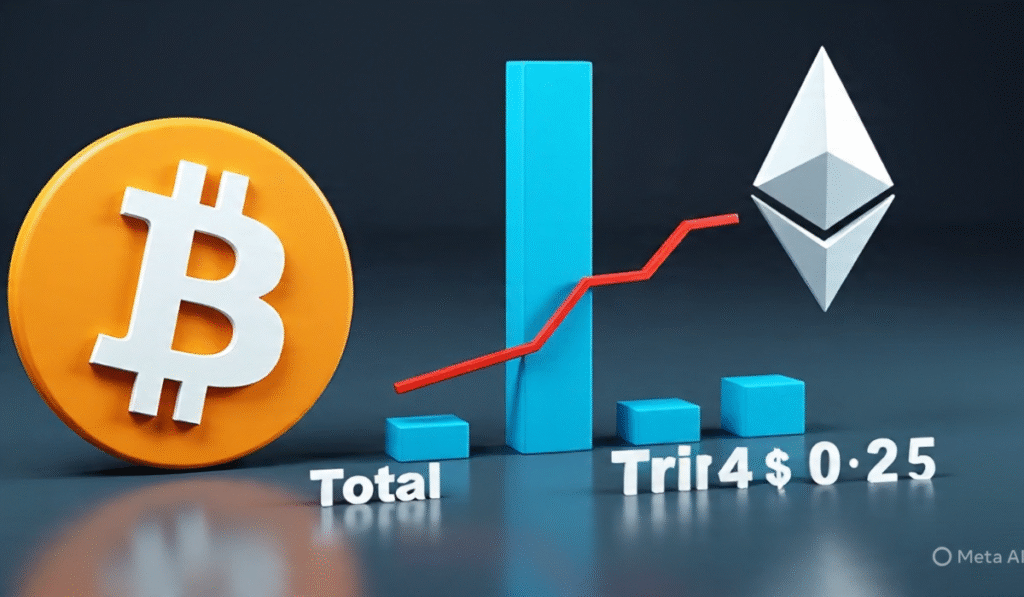Introduction: A $4 Trillion Milestone
Financial markets have been shaken by the official $4 trillion total value of the cryptocurrency sector. Every investor, analyst, or even skeptic has the same question now: Is this the next bull run in crypto or just another temporary pump?
This was the last moment of excitement before the market in late 2021. Subsequently, crypto suffered regulation, recession fears, and innovation fatigue. But today things have actually changed when new numbers presume otherwise.
What is the Total Crypto Market Cap?
Moreover, total crypto market cap is wholly the aggregate value of all cryptocurrencies that exist currently. It includes coins such as Bitcoin, Ethereum, stablecoins, altcoins, and even anything newly emerging like the tokenized securities.
Why It Matters:
- It measures overall market health.
- It helps investors track macro trends.
- It signals sentiment and capital inflow.
Crossing from $4T is not only symbolic. It is a confluence of masses, aisles, and tech maturity stamped in history.
How the Market Reached $4 Trillion
This rampage didn’t happen overnight, it involved several years of steady growth, several regulatory milestones, and a mounting demand for digital alternatives to the traditional financial ecosystem.
| Year | Total Market Cap | Notable Events |
|---|---|---|
| 2017 | $830 billion | ICO boom |
| 2021 | $2.9 trillion | NFTs, DeFi growth |
| 2025 | $4 trillion | Stablecoin regulation, RWA tokenization |
The amount of total crypto market cap reaching $4 trillion reveals more to the investor than excitement: the maturing phase, real-world economies well combining, and the mainstream finance.
The Key Drivers Behind the Surge
This historic event has developed around a number of key themes:
✅ 1. Stablecoin Regulation via the GENIUS Act
Recently passed into law in the United States, the GENIUS Act brought a clear legal framework for stablecoins, generating renewed confidence among institutions.
✅ 2. Tokenization of Real-World Assets (RWA)
Everything from real estate to bonds is now being tokenized, increasingly adding billions of utility-backed value to the blockchain.
✅ 3. AI and DePIN Integration
The rise of Decentralized Physical Infrastructure Networks (DePIN) and AI-backed oracles is enabling real-world application of blockchain data.
✅ 4. Institutional Adoption at Scale
Blockchain-based solutions have been introduced by BlackRock, JPMorgan, and Goldman Sachs. Pension funds and sovereign wealth funds are buying directly into crypto ETFs and tokens.
Bitcoin’s Role in the Rally

Bitcoin (BTC) is still in full charge and thus maintains its dominant position in the crypto arena. As of July 2025, it is trading above $120,000, up nearly 180% since the beginning of this year.
Why the surge?
- Bitcoin is now a key position in all institutional portfolios.
- ETF inflows have driven billions into BTC.
- A digital hedge in inflationary environments.
While it has dipped a little from 44% to its lowest support, it is still a foundational force on which market growth concepts will be built through the subsequent processing of new capital.
Ethereum and Altcoins: Outperforming Expectations
Thus, while bitcoin is the leader in value, Ethereum and altcoins thrive on their technological utility and network effect.
| Coin | Price (July 2025) | 2025 Growth | Sector |
|---|---|---|---|
| Ethereum | $3,800 | +145% | Smart contracts / DeFi |
| Solana | $180 | +220% | DePIN / dApps |
| Chainlink | $44 | +290% | Oracle / RWA |
| Polygon | $1.50 | +160% | Layer 2 / Scaling |
The driving force for the total crypto market cap would be as heavily pulled by altcoins and infrastructure projects as it would be by Bitcoin itself.
Stablecoins, RWA, and Regulation Fuel Confidence
Stablecoins are now more than just dollar-pegged tokens; today, they are financial instruments recognized by governments, fintech platforms, and central banks in some instances.
- USDC+ and PayPal USD dominate consumer payments.
- Tokenized T-Bills are yielding higher returns than traditional bank savings.
- JPM Coin is used for cross-border settlement.
Thanks to the GENIUS Act, these coins are trusted, regulated, and audited to form a safe bridge between crypto and traditional finance.
Institutional Involvement Reaches New Highs
Thus, the upward leap to $4 trillion would not be possible without a substantial amount of institutional participation.
Institutions Driving the Growth:
- BlackRock: Launched tokenized bond ETFs
- Fidelity: Offers direct crypto investing in retirement accounts
- Goldman Sachs: Developing DeFi-like services for clients
- Visa and Mastercard: Settling transactions via stablecoins
Yet institutional capital validates the legitimacy of this dynamic, pushing total crypto market capitalization away from mere speculative thresholds into long-term asset territory.
Comparing Past Bull Runs to 2025
Let us examine how the present bull market differs from previous ones:
| Cycle | Peak Market Cap | Key Drivers | Outcome |
|---|---|---|---|
| 2017 Bull Run | $830B | ICOs, retail hype | Crash in 2018 |
| 2021 Bull Run | $2.9T | NFTs, DeFi, stimulus money | Bear market 2022 |
| 2025 Bull Run | $4T | Regulation, RWA, institutions | Ongoing growth |
Now, unlike previous cycles, this is the first run that is truly integrated with regulations and institutional confidence, thus making it sustainable.
Are We in a Bull Market or a Bubble?
It’s a fair question; fast growth is usually followed by worry. This time, however, feels like a different one.
Signs of a True Bull Market:
- Higher lows during corrections
- Strong fundamentals behind top assets
- Increasing on-chain activity
- Media sentiment not overly euphoric—yet
While price might outpace utility in the short run, the critical metrics back the thesis that this is a structured bull market and not merely a bubble.
What Investors Should Watch Now
Even in a bull market, investors must try to have their feet on the ground.
🛠️ Key Strategies:
- Diversify into Layer 1s, RWA tokens, and stable-yield platforms.
- Dollar-cost averaging, or DCA, reduces entry risk.
- Watch out for macro events such as inflation, rate cuts, or geopolitical tensions.
- Follow regulatory news, especially coming out of the EU and Asia, as global crypto laws evolve.
The most important: don’t chase green candles. Strategy beats emotion in crypto every time.
Final Thoughts: Welcome to the Next Crypto Era
The total crypto market cap reaching $4 trillion is more than just a milestone—it’s a message. Crypto is not only alive, but thriving, thanks to foundational infrastructure, legitimate regulation, and multi-sector adoption.
Are we in a bull run? The data says yes.
But this isn’t like 2017 or 2021. This is a new era—where blockchain meets real-world finance, and digital assets are not just speculative plays, but strategic investments.
As 2025 unfolds, one thing is clear: crypto has broken through. And the next frontier? It’s already being built.
FAQs
A1. A $4 trillion market cap reflects massive capital inflows and growing investor confidence in cryptocurrencies. It suggests renewed bullish momentum, increased institutional interest, and greater mainstream adoption across sectors.
A2. While it’s a strong bullish indicator, it doesn’t guarantee a full-fledged bull run. Analysts look at multiple factors like Bitcoin dominance, trading volumes, macroeconomic signals, and investor sentiment before confirming a bull market.
A3. The growth is largely driven by top assets like Bitcoin (BTC), Ethereum (ETH), and surging altcoins such as Solana (SOL), Chainlink (LINK), and Real World Asset (RWA) tokens. Stablecoins and DeFi tokens have also contributed significantly.
A4. Analysts predict Bitcoin could break previous highs and even reach $150K–$200K if the bull trend continues, driven by ETF inflows, halving effects, and strong macro demand.
A5. Besides Bitcoin and Ethereum, sectors like DePIN (Decentralized Physical Infrastructure), RWA tokenization, AI tokens, Web3 gaming, and layer 2 networks are seeing explosive growth in the 2025 market.
A6. Risks include regulatory crackdowns, security breaches, high leverage in DeFi, and overhyped tokens. Staying informed and managing risk is essential even during bullish phases.
A7. Beginners should research before investing, diversify their portfolios, avoid FOMO, and consider dollar-cost averaging (DCA). It’s also wise to focus on long-term value rather than chasing quick gains in a potentially volatile bull run.

